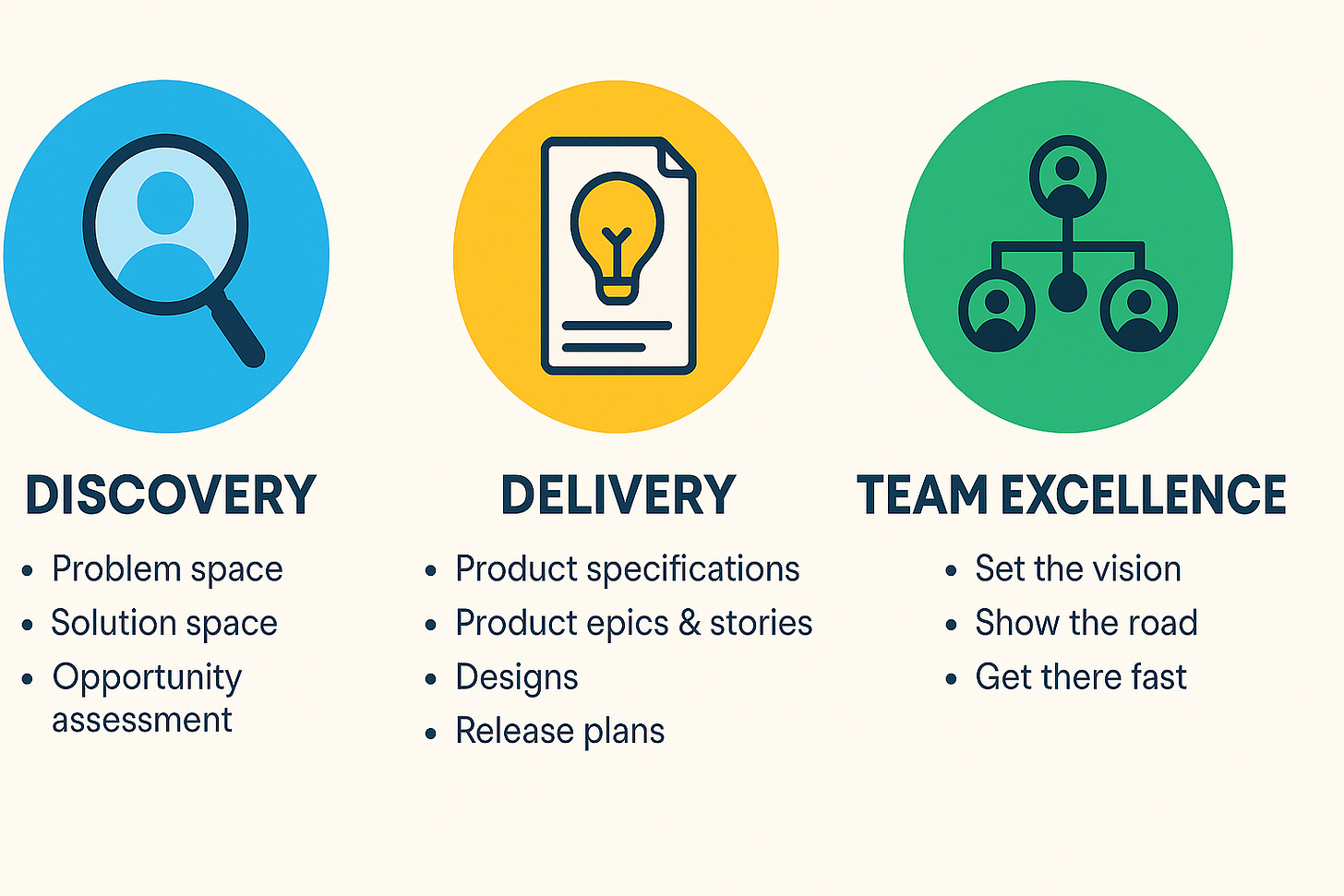The Full Stack of Product Management: Discovery, Delivery, and Team Excellence
Building Great Products Requires More Than Just Shipping
There’s more to great product management than defining features and shipping code. Great PMs—and great PM teams—operate across a full stack that includes discovery, delivery, team leadership, and cultural development.
This post outlines how I think about modern product management across four layers:
Product Discovery
Product Delivery
Product Leadership
Team Excellence
1. Product Discovery: Explore the Right Problems
Every product journey starts in the discovery phase, where you define both the problem space and the solution space.
✅ Problem Space
PMs are responsible for deeply understanding user problems. This isn’t a one-time survey—it’s an ongoing cycle of user interviews, stakeholder feedback, and sometimes just spotting a problem yourself.
When assessing a problem, I ask:
How painful is this problem? Is it a daily frustration or a rare annoyance?
How common is it? Does it affect a few users or an entire market?
How much will our solution reduce the pain? Will people adopt it quickly? Will it change habits?
How feasible is the solution? Can we build this now, or do we need major ecosystem shifts to support it?
💡 Solution Space
Once the problems are well understood, we move to solutioning. This is where brainstorming, stakeholder feedback, and user validation come into play. The goal isn’t just to generate ideas—it’s to identify the highest ROI opportunities.
That’s where the Opportunity Assessment comes in.
Opportunity Assessment
An opportunity assessment is a concise 1–2 page document that outlines:
Impact: What will change if we succeed?
Effort: How hard is this to build?
Risks: What could go wrong?
Market/context: Why now?
This becomes the business case for prioritizing one opportunity over another.
2. Product Delivery: Execute with Precision
Once a solution is prioritized, we move into delivery—translating intent into product experiences.
This includes:
Epics and user stories that clearly communicate goals to engineering
Designs (wireframes, prototypes, high-fidelity mocks)
Copy/content that aligns with tone, clarity, and intent
Milestones and release planning
📊 Impact Assessment
Every feature we ship should be followed by a thoughtful impact assessment. Did we solve the problem we set out to solve? Did the solution live up to the promise made in the opportunity assessment?
Impact can be:
Quantitative: Adoption, engagement, revenue, retention
Qualitative: User feedback, satisfaction, sentiment
This loop completes the discovery-to-delivery cycle.
3. Product Leadership: Lead with Purpose
Leading a product team is a lot like practicing servant leadership. The job of a PM leader is to:
🎯 Set the Vision
Define what success looks like. Where are we going? Why does it matter?
🧭 Show the Road
Help your team navigate uncertainty. There are many ways to go from A to B—your job is to help them find the shortest, most impactful path.
🏃 Get There Faster
Once the path is clear, remove roadblocks and accelerate progress. That can include:
Coaching and skill development
Unblocking bureaucracy
Rolling up your sleeves to help deliver
Hands-on leadership is key. The best leaders aren’t just “meeting managers.” They’re right there in the weeds when it matters.
4. Striving for Team Excellence
If you want to build world-class products, you need a world-class team. That means building systems and rituals that push everyone to get better—together.
One tactic I’ve found effective: Team Excellence Initiatives—each owned by a senior PM with their own OKRs. These focus on growth in targeted areas like:
📚 Knowledge Sharing
Weekly Slack posts with useful insights
Team-led knowledge presentations
Guest speakers (internal or external)
Shared reading + group application of takeaways
Courses, certifications, conferences
🌐 Remote Team Bonding & Culture
Biweekly virtual hangouts for fun and connection
Rotating triads for monthly coffee chats
Annual team offsite to bond, brainstorm, and reset
Fitness or fun competitions (yes, even workout challenges!)
Culture is not accidental. In remote teams especially, it needs to be designed intentionally.
Final Thought: OKRs are Anchors, Not Chains
One final note: OKRs are critical, but they’re not handcuffs. PMs should commit to achieving outcomes—not delivering specific initiatives. Initiatives may change as we learn. The destination stays the same, but the path can (and should) adapt.
A strong OKR system includes goals like:
Number of user research sessions per quarter
Key result metrics aligned to user impact
Clear tie-in to problem space, not just feature output
In Summary
Great PMs don’t just ship features. They:
Understand problems deeply
Identify high-impact solutions
Lead cross-functional teams with clarity
Create a culture of excellence
This is how product managers become force multipliers—not just for their teams, but for their entire organizations.

